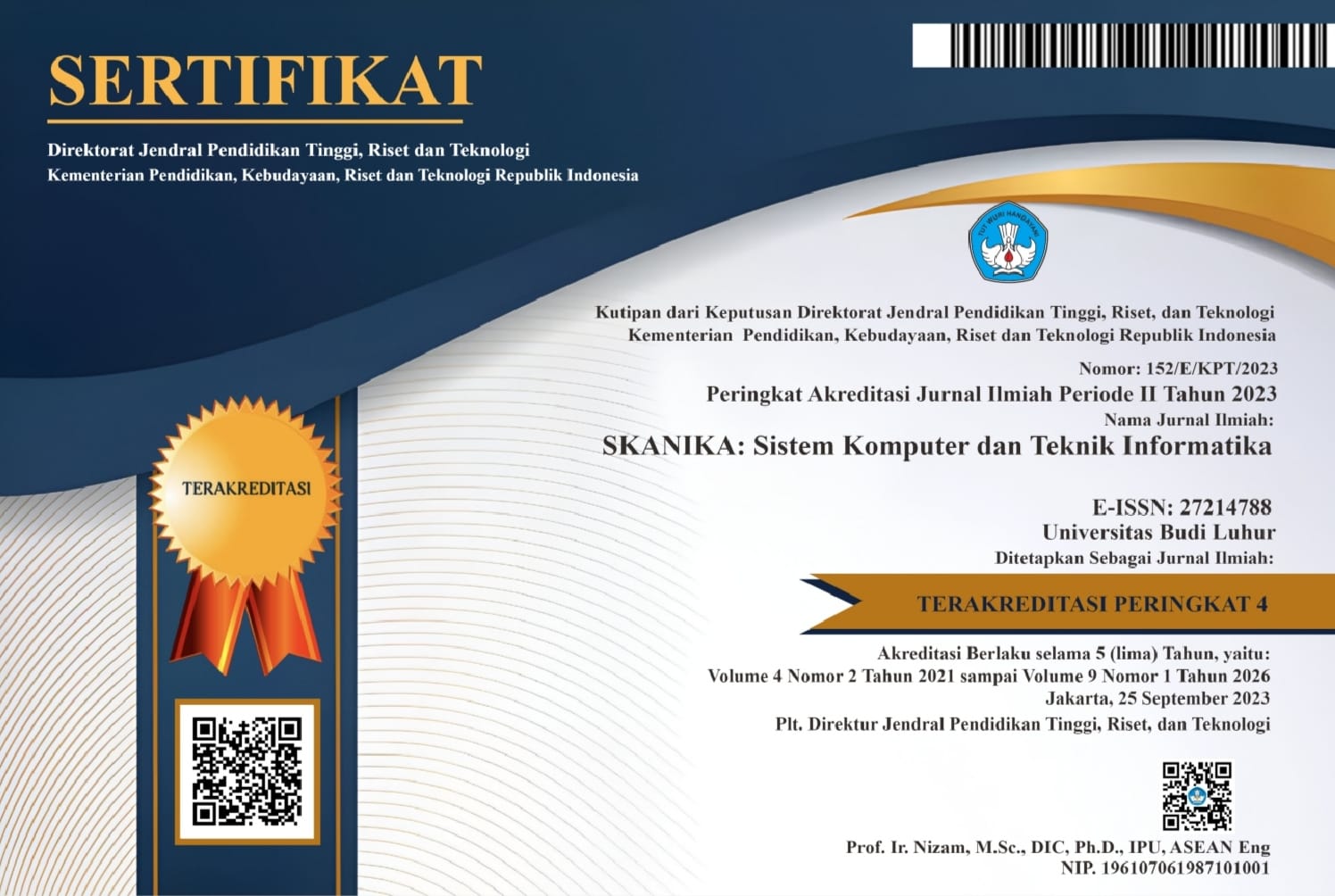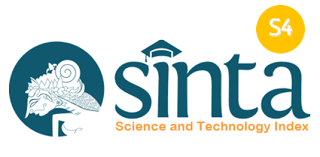PERBANDINGAN TEKNIK OPTIMASI GRID SEARCH DAN RANDOMIZED SEARCH DALAM MENINGKATKAN AKURASI METODE KLASIFIKASI SVM PADA SENTIMEN ULASAN PENGGUNA APLIKASI JKN MOBILE
DOI:
https://doi.org/10.36080/skanika.v8i1.3328Keywords:
support vector machine, grid search, randomized search, sentimen analysis, SMOTEAbstract
This study discusses the comparison of two optimization techniques, Grid Search and Randomized Search, in improving the accuracy of the Support Vector Machine (SVM) classification method in sentiment analysis of JKN Mobile application user reviews. The problem faced is the low accuracy of SVM classification in sentiment analysis when hyper parameters are not optimized effectively. This study aims to identify a more effective optimization technique in improving the performance of the SVM model. The research methodology includes the steps of collecting user review data, preprocessing, feature extraction, data sharing, model training, hyper parameter optimization, and model evaluation. In addition, Synthetic Minority Over-Sampling Technique (SMOTE) is used to handle class imbalance. The results show that the combination of SVM with Randomized Search provides the highest accuracy of 82%, compared to Grid Search which produces an accuracy of 81.5%. The execution time for Randomized Search is also faster, which is 1 minute 21 seconds compared to Grid Search which requires 3 minutes 28 seconds. The SMOTE technique successfully improves the balance of the distribution of negative, neutral, and positive sentiment classes, although the F1-score values for the neutral and positive classes remain low. In conclusion, Randomized Search is superior in terms of time efficiency and accuracy improvement, although challenges still remain in classifying neutral and positive sentiments.
Downloads
References
[2] D. A. Anggoro and S. S. Mukti, “Performance Comparison of Grid Search and Random Search Methods for Hyperparameter Tuning in Extreme Gradient Boosting Algorithm to Predict Chronic Kidney Failure,” International Journal of Intelligent Engineering and Systems, vol. 14, no. 6, pp. 198–207, 2021.
[3] R. Habibi, “Svm Performance Optimization Using PSO for Breast Cancer Classification,” Budapest International Research in Exact Sciences (BirEx) Journal, vol. 3, no. 1, pp. 741–754, 2020.
[4] S. Rabbani, D. Safitri, N. Rahmadhani, A. A. F. Sani, and M. K. Anam, “Perbandingan Evaluasi Kernel SVM untuk Klasifikasi Sentimen dalam Analisis Kenaikan Harga BBM,” MALCOM: Indonesian Journal of Machine Learning and Computer Science, vol. 3, no. 2, pp. 153–160, 2023.
[5] T. Sugihartono, R. Rian, and C. Putra, “Penerapan Metode Support Vector Machine dalam Classifikasi Ulasan Pengguna Aplikasi Mobile JKN,” vol. 7, no. 2, pp. 144–153, 2024.
[6] M. Nurmalasari, N. Anggita Temesvari, S. Ni, and matul Maula, “Analisis Sentimen terhadap Opini Masyarakat dalam Penggunaan Mobile-JKN untuk Pelayanan BPJS Kesehatan Tahun 2019,” 2020.
[7] N. B. B. Tjikdaphia and S. Sulastri, “Comparison of Nbc, SVM, Knn Classification Results in Sentiment Analysis Of Mobile JKN,” JURTEKSI (Jurnal Teknologi dan Sistem Informasi), vol. 9, no. 4, pp. 665–672, 2023.
[8] P. Arsi and R. Waluyo, “Analisis Sentimen Wacana Pemindahan Ibu Kota Indonesia Menggunakan Algoritma Support Vector Machine (SVM),” Jurnal Teknologi Informasi dan lmu Komputer, vol. 8, no. 1, pp. 147–156, 2021.
[9] P. Arsi, R. Wahyudi, and R. Waluyo, “Optimasi SVM Berbasis PSO pada Analisis Sentimen Wacana Pindah Ibu Kota Indonesia,” Jurnal RESTI (Rekayasa Sistem dan Teknologi Informasi), vol. 5, no. 2, pp. 231–237, 2021.
[10] R. Darmawan and A. Surahmat, “Optimalisasi Support Vector Machine (SVM) Berbasis Particle Swarm Optimization (PSO) Pada Analisis Sentimen Terhadap Official Account Ruang Guru Di Twitter,” Jurnal Kajian Ilmiah, vol. 22, no. 2, pp. 143-152, 2022.
[11] V. Kevin, and S. Que, “Analisis, S. Transportasi, A. Iriani, and H. D. Purnomo, “Analisis Sentimen Transportasi Online Menggunakan Support Vector Machine Berbasis Particle Swarm,” Jurnal Nasional Teknik Elektro dan Teknologi Informasi (JNTETI), vol. 9, no. 2, pp. 162-170, 2020.
[12] D. Wirasasmita, and E. Anisa, “Analisis Sentiment Twitter Berbasis Grid Search Algorithm (GSA) dengan Metode Support Vector Machine (SVM) Twitter,” Jurnal Asiimetrik: Jurnal Ilmiah Rekayasa Dan Inovasi, vol. 5, no. 1, pp. 35–42, 2023.
[13] V. W. D. Thomas and F. Rumaisa, “Analisis Sentimen Ulasan Hotel Bahasa Indonesia Menggunakan Support Vector Machine dan TF-IDF,” Jurnal Media Informatika Budidarma, vol. 6, no. 3, pp. 1767-1774, 2022.
[14] F. Rahmadayana, and Y. Sibaroni, “Sentiment Analysis of Work from Home Activity using SVM with Randomized Search Optimization,” Jurnal RESTI (Rekayasa Sistem dan Teknologi Informasi), vol. 5, no. 5, pp. 936–942, 2021.
[15] T. Sugihartono, R. Rian, and C. Putra, “Penerapan Metode Support Vector Machine dalam Classifikasi Ulasan Pengguna Aplikasi Mobile JKN,” SKANIKA: Sistem Komputer dan Teknik Informatika, vol. 7, no. 2, pp. 144–153, 2024.
[16] R. Umar, S. Sunardi, and M. N. A. Nuriyah, “Comparing the Performance of Data Mining Algorithms in Predicting Sentiments on Twitter,” Jurnal RESTI (Rekayasa Sistem dan Teknologi Informasi), vol. 7, no. 4, pp. 817–823, 2023.
Downloads
Published
How to Cite
Issue
Section
License
Copyright (c) 2024 Agus Dendi Rachmatsyah, Tri Sugihartono, Khoiril Irfan

This work is licensed under a Creative Commons Attribution-ShareAlike 4.0 International License.
CC BY-SA 4.0
Creative Commons Attribution-ShareAlike 4.0 International
This license requires that reusers give credit to the creator. It allows reusers to distribute, remix, adapt, and build upon the material in any medium or format, even for commercial purposes. If others remix, adapt, or build upon the material, they must license the modified material under identical terms.
BY: Credit must be given to you, the creator.
SA: Adaptations must be shared under the same terms.ng












